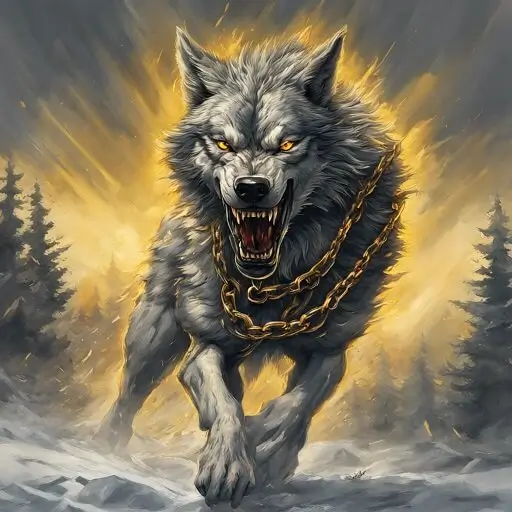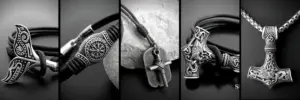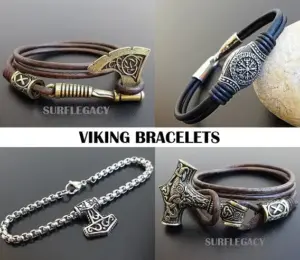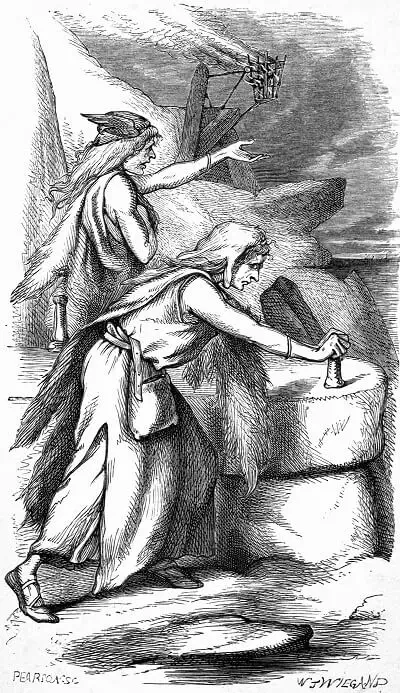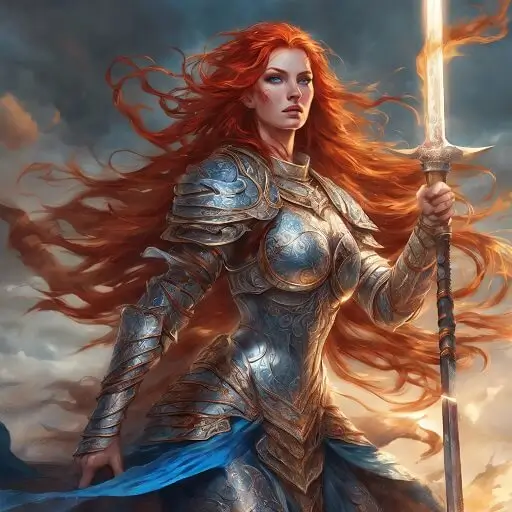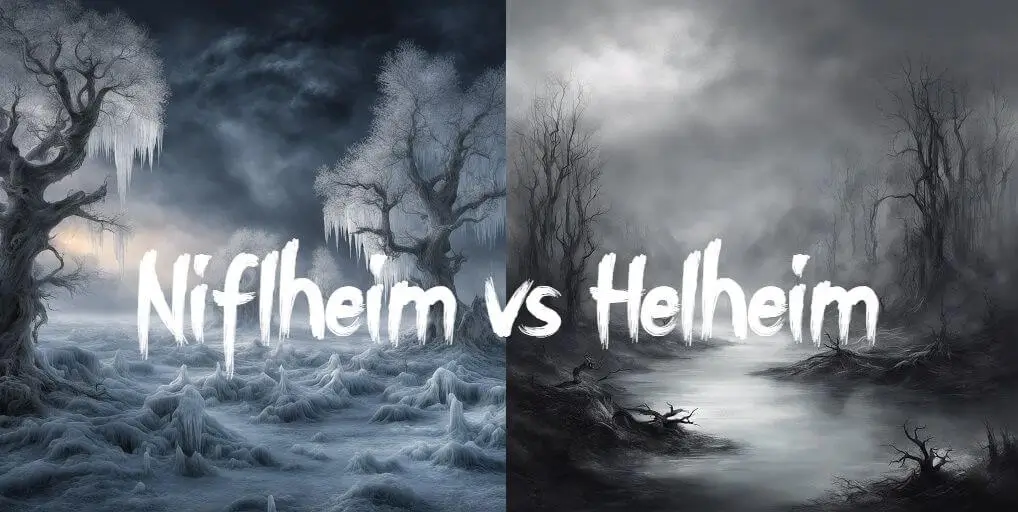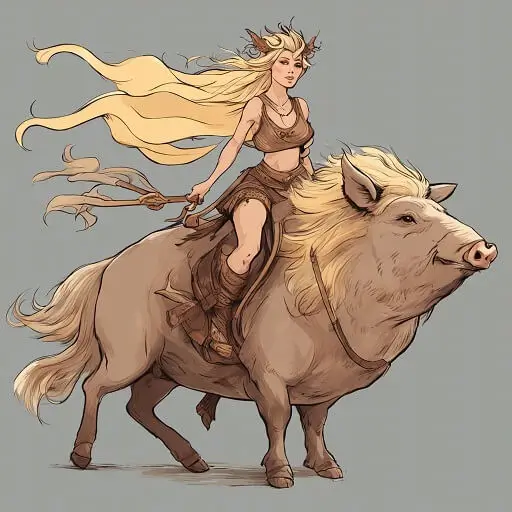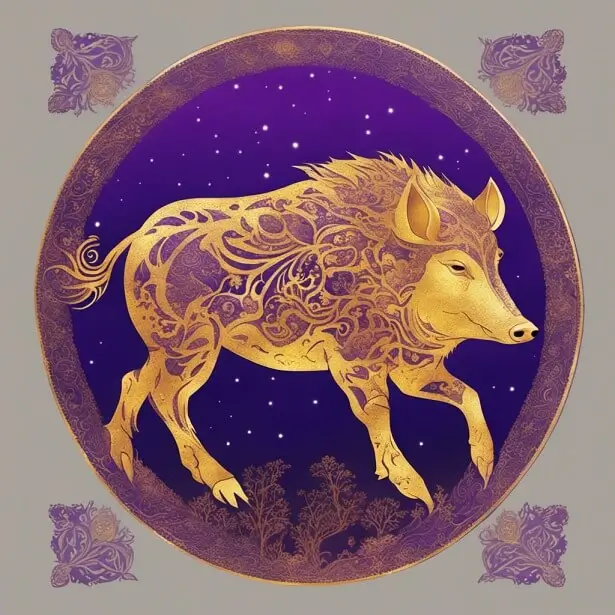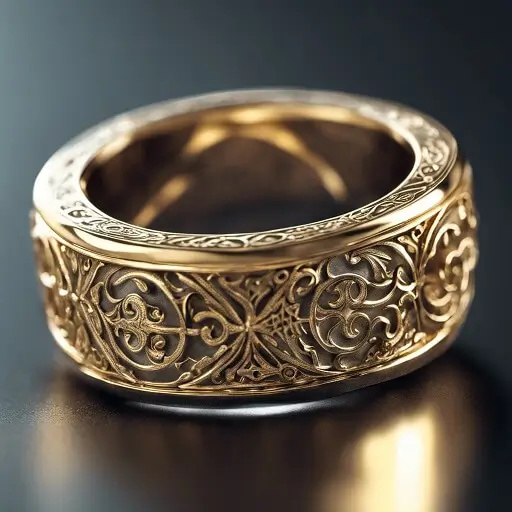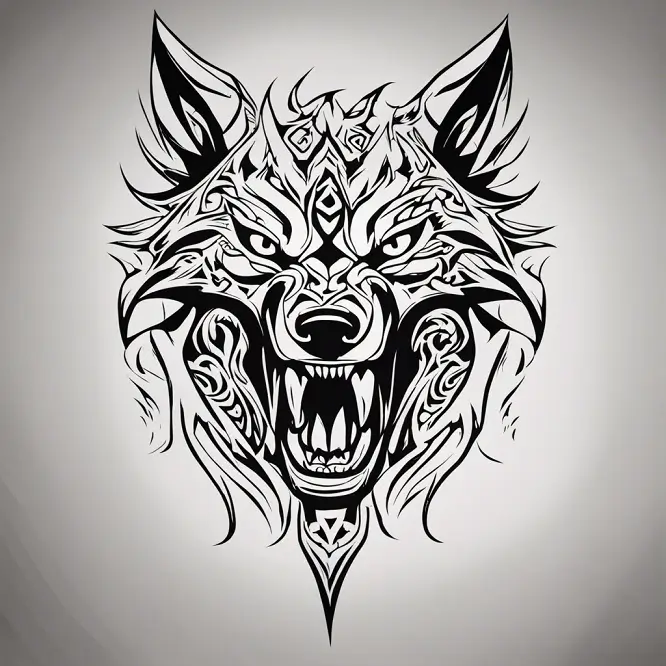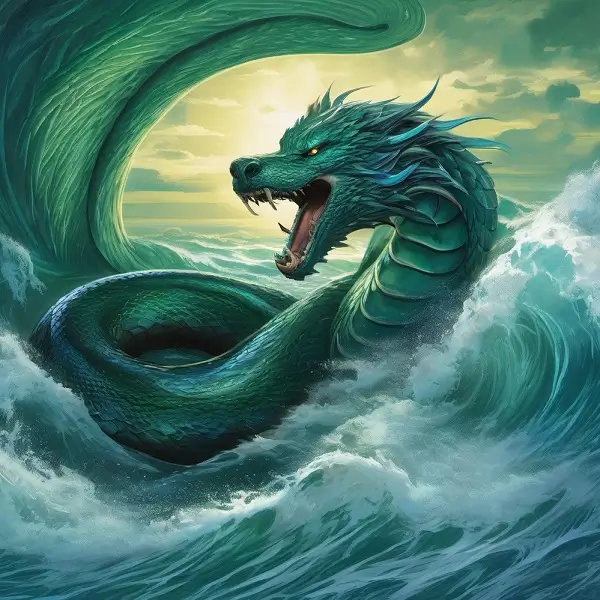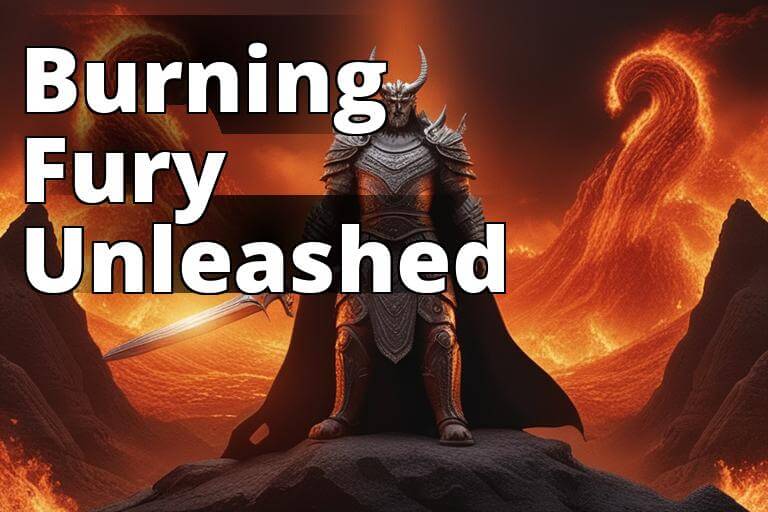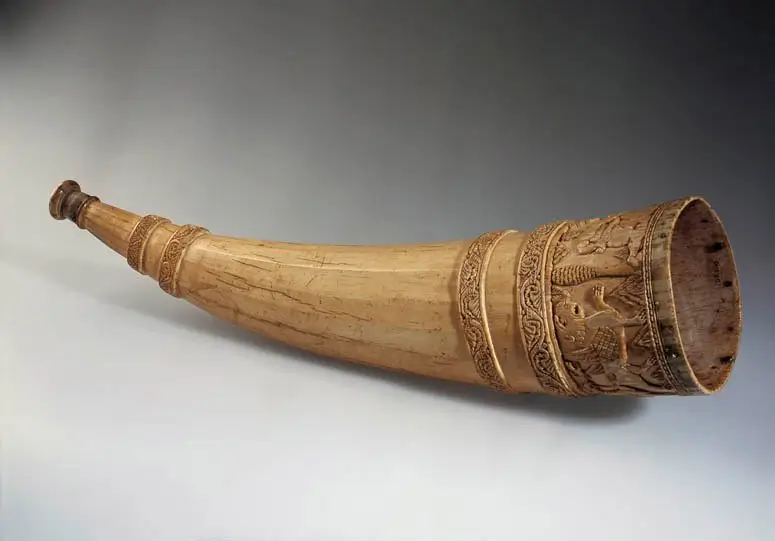In Norse mythology, Gleipnir is an enchanted binding that restrains the mighty wolf Fenrir. This mystical rope is woven from seemingly delicate materials – the sound of a cat’s footfall, a woman’s beard, the roots of a mountain, the breath of a fish, and the spittle of a bird.
Yet despite its fragile appearance, Gleipnir is imbued with powerful magic that makes it unbreakable. The creation of Gleipnir is a tale of gods and supernatural forces, and its strength reflects the belief in ancient Norse sorcery.
The Binding of Fenrir
Fenrir was one of three monstrous wolves born to Loki, the trickster god, and the giantess Angrboda. Along with his siblings – the great sea serpent Jörmungandr and Hel, ruler of the underworld – Fenrir spelled trouble for the gods. As the wolves grew at an alarming rate, the gods began to fear the havoc they could wreak.
Seeing the danger, the Allfather Odin commanded the dwarves to forge special chains that could bind the wolf Fenrir. The dwarves created the first fetter Gleipnir from the sound of a cat’s footfall and a woman’s beard, staunch and smooth but stronger than any iron chain. This was placed on Fenrir, but with a quick snap of his mighty jaws, Fenrir broke free of his bonds.
The gods tried again with a stronger binding, Dromi, made of the roots of a mountain. Yet again, Fenrir shattered these chains. For the third attempt, the dwarves fashioned the silken ribbon Gelgja from the sinews of a bear and the breath of a fish. But Fenrir continued to demonstrate his great strength by tearing apart these binds as well.
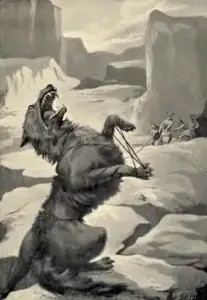
Binding Fenrir
It was clear that an even stronger fetter would be needed to restrain Fenrir. Odin decreed that a special rope be constructed from materials no one would expect to have such power. And so, the smooth, slender Gleipnir was woven from the beard of a woman, the roots of a rock, the breath of a fish, the spittle of a bird, and the sound a cat makes when it moves.
The Crafting of Gleipnir
Though it appeared insubstantial, Gleipnir was imbued with powerful magic. Its delicate strands contained the strength of mountains and the secrecy of the occult.
Some accounts say the materials were collected with spells and chanted charms to draw out their hidden might. Other tellings describe how only under the cover of magic could such unlikely components be transformed into an unbreakable bond.
The creation of Gleipnir drew on the arcane wisdom of the dwarves as well as the guile of the gods. Its slender form concealed a sturdy binding fueled by sorcery. This was a fetter that would hold even the mightiest wolf.
The gods went to Fenrir and proposed a game – let them place this silken ribbon Gleipnir upon the wolf and observe if he could escape. Being boastful of his great strength, Fenrir agreed.
But this time as he strained, twisted, and contorted himself, even Fenrir could not snap the slender Gleipnir. The more the wolf thrashed, the tighter and stronger the fetter became. Fenrir found himself completely bound and at the mercy of the gods.
Magical treasures created by dwarves for the Norse gods:
| Object | Description of Powers |
|---|---|
| Mjölnir | Thor’s hammer, forged by dwarves Sindri and Brokkr. Possessed the power to level mountains and was impervious to most blows. Always returned to Thor’s hand when thrown. |
| Sif’s Hair | Replaced the golden hair Loki cut from Sif’s head as a prank. The dwarf-crafted replacement hair magically grew like natural hair. |
| Draupnir | Odin’s ring that dripped 8 new gold rings every 9 days. |
| Gullinbursti | Freyr’s golden boar that could run through air and water. Its bristles glowed in the dark. |
| Skíðblaðnir | Freyr’s foldable ship that always had a favorable wind when sailing and could contain all the Norse gods. |
| Gleipnir | Slender silken ribbon that could bind even the mighty Fenrir wolf due to its magical crafting. |
| Gungnir | Odin’s spear imbued with runic power. It never missed its target and always returned to Odin’s hand when thrown. |
| Brísingamen | Necklace of the goddess Freya of incomparable beauty and radiance. |
The Power of Gleipnir
Gleipnir’s slim appearance hid shocking strength drawn from the occult materials used to craft it. This allowed the gods their victory over Fenrir where iron chains had failed.
The qualities that make Gleipnir so resilient can be seen as metaphors for the nature of binding magic itself – what seems delicate on the surface can contain untold power in its depths.
Gleipnir was slippery and supple, yet firmer than any steel, allowing it to confine Fenrir no matter how violently the wolf struggled. The smoothness came from the spittle of a bird, deftly coating each strand, while the roots of a mountain gave stability that anchored deep within the earth.
The beard of a woman and breath of a fish lent obscurity, concealing Gleipnir’s true nature much as magic often works in secret ways. And the cat’s footfall imbued stealth into the binding, clinching tighter with every twist and turn of Fenrir’s body.
Even the way Gleipnir was forged draws on the mystical qualities of binding magic. The esoteric nature of its materials required special rituals and charms to transform them into an unbreakable rope. Dwarves and gods collaborated, weaving sorcery into every thread.
The power of Gleipnir therefore comes not just from the tangible components used to craft it, but also from the arcane knowledge tapped into during its making. This reflects how binding spells often rely on occult wisdom to produce what sheer physical force cannot.
So while Gleipnir appeared as thin silken ribbons, they concealed sturdy magic binding Fenrir in an unescapable grip. The more Fenrir strained against them, the stronger and tighter Gleipnir’s hold became. Truly, the slender Gleipnir fulfilled its purpose in harnessing Fenrir’s monstrous might.
The Imprisonment of Fenrir
With Fenrir rendered helpless by Gleipnir’s binding, the wolf found himself at the mercy of the gods. The Aesir took no chances – still cautious of Fenrir’s strength should he somehow break free.
They dragged the bound wolf to a remote island called Lyngvi, deep in the Lake Amsvartnir. There the gods fastened one end of Gleipnir to a giant boulder buried deep in the earth.
The other end they threaded through Fenrir’s jaws and tied to a massive rock slab that was jammed firmly into the wolf’s maw. Fenrir would remain pinned on this desolate island, unable to free himself or wreak havoc.
It was said that as a final insult, the sword of the god Tyr was wedged into Fenrir’s upper jaw to keep it propped open. Fenrir bit off Tyr’s hand in the process – the only damage the otherwise invincible gods suffered in their quest to subdue the wolf.
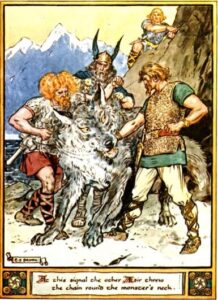
Tyr being bitten by Fenrir
But with Fenrir immobilized on Lyngvi, helpless and alone, the gods had succeeded in preventing further chaos. Their troublesome foe would trouble them no more.
Yet their victory came with a cost. The mighty wolf Fenrir was fated to break free come Ragnarok, the cataclysmic battle at the end of the world.
When that time came, only the god Vidar would be able to take vengeance for the Aesir by slaying the unleashed Fenrir. Until then, the magical bonds of Gleipnir would keep the wolf restrained despite his earth-shattering strength.
The Symbolism of Gleipnir
On one level, the myth of Gleipnir and Fenrir was a way for the ancient Norse to explain cosmic forces beyond their understanding. The uncontrollable wolf symbolized the destructive power of fire, natural disasters, even death itself – a chaotic brute strength capable of tearing down the ordered world of gods and men.
Gleipnir represented the power of magic, sorcery, and cunning that could contain and resist such raging calamity.
But the tale also embodied more universal themes about the nature of binding and restraint. Gleipnir suggested that what appears harmless on the surface can contain hidden strength when created through magic and guile.
Fenrir represented unchecked freedom and the danger it poses when taken to extremes. His binding warned that even the greatest power could be tamed through clever means.
On a philosophical level, some see the story as a metaphor about how civilization exerts control over humankind’s baser instincts. Fenrir personified animal impulses and lack of reason.
Gleipnir symbolized how law, order, and culture – even when seeming fragile – can successfully rein in humanity’s more primal urges.
Ultimately, the myth of Fenrir and Gleipnir wove together Norse lore, cultural values, and timeless concepts about binding and restraint. This may explain why a myth born centuries ago still resonates – even across cultures – today.
The symbols at its heart go deeper than any single society or time period.
Key Facts About Gleipnir:
- Gleipnir was an enchanted rope or binding made to hold the wolf Fenrir in Norse mythology.
- It was crafted from the insubstantial materials of a cat’s footfall, a woman’s beard, the roots of a mountain, the breath of a fish, and the spittle of a bird.
- Through magic, these delicate components were transformed into a slender but unbreakable bond even Fenrir could not break.
- Fenrir had easily shattered previous iron-wrought chains and fetters, so Gleipnir’s strength derived from sorcery.
- After Fenrir was bound by Gleipnir, the gods dragged him to the island Lyngvi where he was impaled and left to await Ragnarok.
- Gleipnir represents how mystical wisdom and guile can create power from weakness to restrain even the mighty.
- The myth symbolizes binding chaos through civilization, and freedom surrendered for security.
Gleipnir remains one of the most intriguing magical objects in Norse mythology. Its role binding the ferocious Fenrir has captured imaginations for generations. While short, the tale carries deep symbolism that continues to resonate in the present day.
Frequently Asked Questions About Gleipnir
Why was Fenrir destined to kill Odin at Ragnarok?
As a child of Loki, Fenrir was prophesied to kill the head of the Norse gods, Odin, during the apocalyptic battle of Ragnarok. This likely represented the downfall of order and civilization at the end of the world.
How exactly did the gods manage to get Gleipnir on Fenrir?
The gods pretended to propose a game to Fenrir, flattering his pride and challenging whether such a delicate silken ribbon could really bind his mighty strength. Fenrir arrogantly agreed to prove he could break any binding.
What happened to Fenrir’s siblings, Hel and Jörmungandr?
Hel was banished to the underworld to rule over the dishonorable dead. Jörmungandr was tossed into the ocean surrounding Midgard, where he grew so large he could encircle the earth and grasp his own tail.
Why was Tyr the only god brave enough to feed Fenrir in Asgard?
As the god of law and justice, Tyr upheld his duty despite the danger. The other gods were too afraid of Fenrir’s growing power.
How did the gods manage to collect such ephemeral materials for Gleipnir?
The gods likely used magic spells and occult rituals to gather the substances, like the sound of a cat walking, which do not normally exist in tangible form.
Why was Fenrir’s bite able to injure Tyr when the gods were otherwise invincible?
Fenrir’s bite carried such primal chaos that it could overcome Tyr’s divine attributes, much as Fenrir was fated to kill Odin at Ragnarok.
How did the gods transport the bound Fenrir to the island Lyngvi?
As a team, they likely had to drag the thrashing wolf, who remained very strong despite the binding, to the remote island for imprisonment.
Why was the island Lyngvi chosen as Fenrir’s prison?
Its isolated location prevented Fenrir from causing destruction, and the cave and boulders allowed chaining him down thoroughly. The lake added further security.
Could another god like Thor or Odin have broken Gleipnir?
Gleipnir’s power was divine and absolute, so it is likely no other god could break its magical binding, only Fenrir at Ragnarok.
How will Fenrir ultimately break his bonds at Ragnarok?
As the cosmos comes undone, Gleipnir will weaken just enough for Fenrir to shatter its binding through his apocalyptic strength.
What does Gleipnir represent?
Gleipnir represents how mystical knowledge and cunning can create hidden strength. Its power reflects the belief in Norse sorcery. The myth symbolizes binding chaos through order and civilization.
Why did Fenrir bite off Tyr’s hand?
Fenrir bit off Tyr’s hand in vengeance after realizing the gods had deceived him into being bound through trickery and breach of oath.
Conclusion
The myth of Gleipnir and its role in binding the mighty Fenrir remains one of the most fascinating tales from Norse legend. At its core, this story blends magic and guile to overcome sheer brute force. It reminds us how cunning and occult knowledge can surpass what straightforward strength alone cannot achieve.
Gleipnir represents in many ways the very essence of binding power itself – physically delicate yet imbued with resilience from its crafted magic. Fenrir symbolizes unfettered freedom that, pushed to extremes, turns dangerous and chaotic. The gods show that ruling through sworn oaths and lawful order, though seeming flimsy, maintains civilization better than unchecked liberty.
While born centuries ago, the myth still resonates today. Its symbols reflect timeless struggles of chaos against control, animal impulse versus human reason, and freedom restrained for security. We face these competing forces within our own minds.
The legend also shows binding as a mixed blessing. The gods bound destructive might, but tyranny lurks in any restraint forced through deception. Fenrir was bound by trickery, not consent. And binding any sentient being, even a wolf, sprouts an ethical thorn.
Does Gleipnir represent shrewd rulers outsmarting a brute? Or overbearing order trampling freedom? Its meaning shifts in different light. The myth refuses simplistic labels of good and evil. All parties have valid shades of right and wrong. Such nuance contributes to the story’s enduring richness.
Gleipnir and Fenrir will populate human imagination as long as runes remain carved and sagas are told. This brief fable so masterfully crafted by ancient storytellers continues to reflect something meaningful about our own natures back to us. Its symbols expose truths both timeless and timely. And for that, we thank the Norse bards who kept this tale alive through the ages.
See also:
The Mjölnir Pendant: An Icon Through Time
Draupnir – The Magical Ring of Odin in Norse Mythology
Gungnir – The Legendary Spear of Odin
Shop Norse Jewelry
Are passionate about Norse Mythology?
Finding the ideal piece of Norse Jewelry can be challenging and time-consuming, especially if you lack inspiration or don’t know where to look.
Surflegacy, has you covered. We have a wide range of Handmade Jewelry in various styles, shapes, colors, and materials, to accentuate your Norse spirit and look. Do not hesitate to visit our selection HERE

